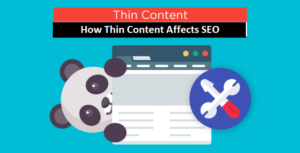What is Thin Content and How to fix it for Better SEO in 2020?
- November 17, 2020
- Content Writing, SEO, SEO Friendly Web Development

Have you heard about fat or thin content? What is exactly meant by thin or thick content? Many website owners and clients suffer from low engagement rates and complain about low ranking of their websites. A lot of people are confused about their low engagements of customers never conduct a content audit to find out the reasons behind their failure to attract customers. So that brings to a question that what is the role of thin content in all that?
A thin content is referred to as a content that has low or no value for the clients or visitors. A think content is a published text on your website, blog, or social media that has no significant value in terms of engagements. So how does think contribute differs from quality content and what can you do to remove the thin content from the website to replace it with valuable content? Let us guide you about this most intriguing question in 2020.
The Meaning of Thin Content
As mentioned earlier, thin content as less or no value for the visitors who fail to read the content till the end and often leave your website. There are many copywriters available who charge low rates and often produce a content that has less credibility to succeed over the Internet. In contemporary digital marketing realm, thin content is the biggest dilemma or an epidemic for the digital marketers that ruin their SEO success.
This means that if you keep publishing thin content on your website, it can significantly damage the image of your brand. It can also destroy any possibility of engagement and stop users from taking any profitable action. Especially for small and medium business organization, thin content fails to provide them any value.
There are hundreds of eCommerce sites on the Internet with hundreds of pages and endless product categories. The solution is also simple for those websites; however, it takes a lot of time to implement that content strategy.
Our post will show you by focusing on the three aspects of fixing the thin content such as:
- What thin content is and examples of what type of content is considered thin.
- How you can use tools to diagnose and identify thin content
- And how you can fix some content in those pages to improve your SEO and produce a thin-free content on your website?
How Thin Content Works on your Website

In the days of keyword stuffing and clacking a few years back, it was easier for the websites with competitive keywords. It was difficult to find the content at all ten years ago that was not stuffed with keywords. But which one is good, thin content or quality content?
Of course, the answer is quality content. This is because Google has been intervening and striving to solve these content-related problems in the search results. In the digital marketing realm, one of the biggest disadvantages is to solve the issue of thin content on eCommerce site. Google has severe penalties for thin content; this is the reason why you should worry about it because it can impact your search engine optimization in a negative manner.
This is true that thin content can get your website penalized in a severe way. It can also send the website in the low rankings of Google. Then there should be a way to avoid these issues created by thin content because it hurts your SEO in 2020 big time.
Thin content is also defined by a Search Engine Journal post, “thin content is content on your website that does nothing to improve the quality of search results page. If you are constantly publishing thin content, then it means that the website is not gaining any ranks. For example, take this example on the Google search. If a user types a keyword like “what color is the sky”, and then there must be many websites that state that sky is blue and why it is blue? So if your website is doing nothing new than to just posting the same response about the blue color of the sky, then you are using thin content.
This means that thin content is similar to many other pieces of contents that are already published out there on other blogs or web pages. It is not a coincidence that your content is trying to look like theirs, sometimes, you might have knighting new to say or offer to the readers. So a better way to write your content and eliminate the chances of having a thin content is to write the following words:
“The color of the sky is blue; however, scientists reveal that sky has no color and the blue color is perceived by the human eye due to the patterns of light scattering in the atmosphere”.
How is this content different from the earlier content that was regarded as thin?
This time, you have the same thing to say to the readers, but this answer is not generic or exactly the same as other websites. You have tried to create a value for the readers and ‘the light can scatter through the atmosphere’ part is something that is new for the readers. This helps the readers to gain significant knowledge and also learn about the reason of blue color.
Moreover, on Google, it is a recent trend that the search engine ranks the longer content higher than the short content. So if you are writing amazing 2000 words blog, then you might be adding more value to the readers and creating a valuable content that can give you better chance to rank.
What is Valuable Content for Google?

Value can be hard to define for a person who has no knowledge of Google’s recent guidelines. Some of the content on your website might seem very good to the users, while other may seem useless to them. It all depends on the quality of content they read. This is where the user’s intent plays a vital part in determining the quality of content.
Whether users rank the content high-quality or low quality, it all depends on their intent. In the end, the search engines also decide that how valuable is your content. Keep reading this post till the end so you can know all about the thin content and how can you get rid of this menace that can hurt the SEO in 2020.
A valuable content is something that is supercharged with value. Value relates in the modern times to more knowledge and information you choose to shape and share for your readers. Google highly ranks content as quality content that aims to provide a big value to the readers in terms of more education, information, and knowledge. This means that a valuable content is able to inspire the readers and appreciates them. Like the old saying goes, the value of a good content is in the eyes of a beholder.
How is Thin Content a Problem in 2020?
In 2011, Google started to take the problem of thin content very seriously. The first Panda Update in Google’s algorithm started it all because it introduced a penalty for including thin content on your website. People were so used to using content spinners and automatically posting content on several websites with no regard of keywords and optimization techniques. Moreover, content was also highly irrelevant on several websites with design flaws. A series of Panda updates allowed Google to streamline this issue of prohibiting any chances for marketers to post thin content. This forced the writers and site owners to only post a better-quality content.
Unfortunately, most people in 2020 still think that a good or quality content relates to long-form content and it has everything to do with length. These people believe a notion that the more they write, the more value their content can produce for their website. But what about Google? Does Google think this way also?
A CognitiveSEO post reveals that there is no evidence of long-form content on the Internet to get more likes and shares on the social media. Rather, a more powerful factor revealed was the relevant backlinks that helped the content to rank higher. Therefore, the length of the content matters, but does not matter so much that you can ignore other ranking factors.
In 2019, Google also published a statement that emphasized on the quality of content. This involved discouraging the content that was repeatedly published and adds no value to users’ lives. It is hard to get all the information from different places and there is no way of telling which Internet source is publishing a good content. Especially, in the days of very tough competition and eCommerce boom, SEO can be severely affected by the thin content in 2020.
How Thin Content Affects your SEO?

Google wants users to have more value in terms of content that can increase their knowledge. A good value content as described above does its best to improve the lives of people with solid information. It also makes the search engine happier to rank that content well. Google usually applies manual action penalty to sites that still uses thin content strategy to fool the search engines. For example, if you look at the Google Search Console, you can see that it provides you a heading of thin content that is discovered on your website after analysis.
Despite getting warning from Google, your site might still contain thin content. Since search engines have a massive content to analyze on the Internet and daily crawl millions of pages, it has to do more work. So that brings us to a next question as to where you can find the thin content often.
Where is Thin Content Found on Websites?
On many websites and search engines, thin content is found on bigger websites with hundreds of even thousands of pages. This happens because the site owners often try to help people by posting a blog post of 4000 words that contains thin content. After a certain length, the writer often gets distracted and fails to produce valuable information to the writers in a 5000 words blog. For the sake of helping people, bigger websites and eCommerce stores often have a difficult time to produce a good quality and fluff-free content. Therefore, in thousands of product pages, there are many similarities that are considered as a thin content.
This means that on eCommerce websites, product details are often omitted from the pages where heading of “product details” is given. If there is no content there under the heading of Products Details, this means that buyers will not get any information about the dress they want to buy from your site. All they can see is a fancy model with a black dress; the page does not offer them any information about the specs of the dress and how much it costs?
The pictures of models wearing a fancy dress do not look strange on a fashion magazine; but when you are trying to sell the same skirt or a night gown on your eCommerce site, this creates an issue for the search engines who can find no description of your content. They will look through thousands of pages like this one and find no attractive copy to rank that content. Therefore, let us tell you a solution for this problem.
The solution of this issue is to add a copy of content on your product page. Say the product page for a $100 night gown can tell the users about the product, its color, its size, and how it can be shipped to your destination. Sometimes, thin content is added to the eCommerce sites and gets unnoticed. For instance, you might have a category page that costs a single product. However, when you compare that page with all other eCommerce websites, yours will be considered as a thin content.
How to Identify Thin Content on your eCommerce Site
If you are referring merely to the size of the content, then it is not much difficult to detect the thin content on your eCommerce site using CognitiveSEO tool. The tool also allows you to see the duplicate content on the website that can result in a lot of content-related problems. Similar pages can also be combined using canonical tags. It is a good practice to remove these tags from the search engine results.
How to Fix the Issues of Thin Content on your Site?
Do you want to avoid Google’s penalties on your website? Is your website or eCommerce store filled with thin content? Sometimes, it is easy to fix the thin content-related issues; especially, if you get a manual warning of penalty from Google. If you have thousands of pages, it may take some time to fix this issue due to the volume of pages on your site. However, the panel can also be imposed by Google’s algorithm and there is no warning sign to tell you that you are being penalized. However, you can do a few things in this case to avoid penalties.
1. Make your website Look Legitimate
The first thing to fix thin content is to let your website look legit. This means if Google is looking at your website with all its might and consider it spam my, then it will penalize the website. Make sure that you use a:
- Original template and further customize it to improve the website value
- Have a logo on your website to represent the brand
- Provide an About Us page for more details
- Add a Contact Us page
2. Avoid using Same Titles
Google also takes notice of pages that are left empty on your website. So a good strategy to avoid penalty is to not leave any blank pages on your website. If you are not sure what to write on a particular page, then consult tools like CognitiveSEO or online tools to generate blog ideas. However, care must be taken not to generate the titles that can trigger the alarms of Google.
Using the same title can create an issue. It is also vital to include keywords in your article’s title. It also needs diversity on the part of a content writer. You can train them to add value to your content.
3. Do Not Copy Content on your Website
In the eyes of Google, copying content on your website can be a crime. Especially, if you are copying a product description from another eCommerce site that is selling the same fabric you do. The content can look very same that that ruins the image of your site in the eyes of Google.
This issue arises on eCommerce sites mostly. Many times they also duplicate pages in order to save time and just change a couple of words. This practice will surely consider your website as containing a duplicate content. It also tells Google that your website endorses competitors.
Are you looking for strong SEO-Friendly content for your website?
www.seo.ae provides advanced Website Content Writing service for all SEO purposes. We have professional content writers who analyze your market trends deeply before starting on any project. You will always get quick ranking content for any website types and industry. We also provide professional Digital Marketing service for all business websites. Contact now to find out more.
About us and this blog
We are a digital marketing company with a focus on helping our customers achieve great results across several key areas.
Request a free quote
We offer professional SEO services that help websites increase their organic search score drastically in order to compete for the highest rankings even when it comes to highly competitive keywords.
Subscribe to our newsletter!
Recent Posts
- How to Track Customers and Revenue from SEO in Your CRM? May 1, 2023
- How Could You Block ChatGPT from Using Content of Your Website? March 14, 2023
- How to Make Your Professional Website Mobile Friendly? February 1, 2023








